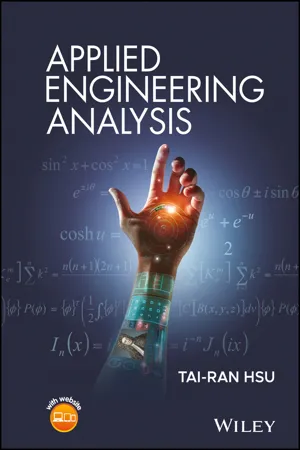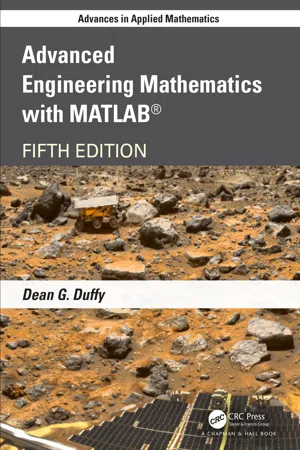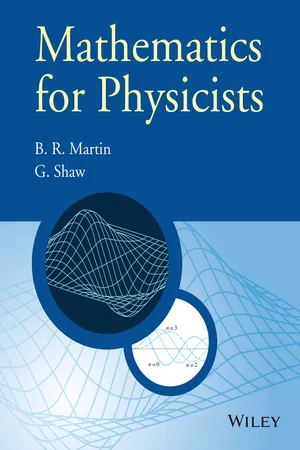Technology & Engineering
Vector Calculus
Vector calculus is a branch of mathematics that deals with vector fields and scalar fields, and their derivatives and integrals. It is used to study and analyze physical phenomena in engineering and technology, such as fluid dynamics, electromagnetism, and mechanics. The concepts of gradient, divergence, curl, line integrals, and surface integrals are fundamental in vector calculus.
Written by Perlego with AI-assistance
Related key terms
6 Key excerpts on "Vector Calculus"
- eBook - ePub
Practical Mathematics for AI and Deep Learning
A Concise yet In-Depth Guide on Fundamentals of Computer Vision, NLP, Complex Deep Neural Networks and Machine Learning (English Edition)
- Tamoghna Ghosh, Shravan Kumar Belagal Math(Authors)
- 2022(Publication Date)
- BPB Publications(Publisher)
HAPTER 3Vector Calculus
Vector Calculus is the study of vector fields and scalar fields. A scalar field is a mapping that assigns a scalar or a real number to every point in a vector space. A vector field assigns a new vector to each point in a vector space. Vector Calculus includes computation of derivatives of scalar and vector fields and integrals over scalar fields. These are the essential tools required in defining optimisation theory and parameter estimation in probability theory, which are the foundational pillars of ML/AI. The theory of Vector Calculus is a generalization of the calculus of functions of single variable to functions of several variables.We will first introduce the fundamentals of real analysis, that is, real valued functions that are easy to visualize. We will elaborate on the differentiability concepts as they are the basis of all function optimisation theory discussed later. Then, will see how these concepts are generalized for functions of several variables: scalar and vector fields.Structure
In this chapter, we will cover the following topics:- Fundamentals of real analysis
- Scalar and vector fields
- Tensors and tensor fields
- Total derivative, partial derivative, derivatives with respect to tensors
- Introduction to function optimization
- Convex functions, Lagrange multipliers
- Gradient descent algorithm
Objectives
This chapter introduces fundamental mathematical background required for understanding deeper concepts in ML. For readers who are fresh college graduates, most of these concepts may be a refresher for them. The main goal of this chapter is to introduce the mathematical optimization theory and algorithms to solve mathematical optimization problems in general.Analysis of real functions
Real analysis is the area of mathematics dealing with real numbers - eBook - ePub
- Tai-Ran Hsu(Author)
- 2018(Publication Date)
- Wiley(Publisher)
Chapter 3 Vectors and Vector CalculusChapter Learning Objectives
- Recap the distinction between scalar and vector quantities in engineering analysis.
- Learn Vector Calculus and its applications in engineering analysis.
- Learn to manipulate expressions of vectors and vector functions.
- Refresh vector algebra.
- Learn the dot and cross products of vectors and their physical meanings.
- Learn about derivatives, gradient, divergence, and curl in Vector Calculus.
- Learn to apply Vector Calculus in engineering analysis.
- Learn to apply Vector Calculus in rigid body dynamics in rectilinear and plane curvilinear motion along paths and in both rectangular and cylindrical polar coordinate systems.
3.1 Vector and Scalar Quantities
In Section 2.2.3 , we introduced functions that represent physical quantities in engineering analyses, and whose values vary with the values of the associated independent variables in space (x, y, z) in a rectangular coordinate system) and time (t). These quantities are called as scalar quantities.There is another group of physical quantities for which not only the magnitude but also the position and the direction are significant and must be represented.. These are called vector quantities. Thus, a speed of 80 km/h of a moving car is a scalar quantity, but a velocity of 80 km/h implies that the car is traveling in specific direction on the road at this speed, so that it is a vector quantity. Engineering analyses involving vectorial quantities will require the use of Vector Calculus, which will be described later in Section 3.5 .A vector, as stated, is characterized by both its magnitude and its direction - eBook - ePub
- Dean G. Duffy(Author)
- 2021(Publication Date)
- Chapman and Hall/CRC(Publisher)
Vector CalculusPhysicists invented vectors and vector operations to facilitate their mathematical expression of such diverse topics as mechanics and electromagnetism. In this chapter we focus on multivariable differentiations and integrations of vector fields, such as the velocity of a fluid, where the vector field is solely a function of its position.4.1 REVIEW
The physical sciences and engineering abound with vectors and scalars. Scalars are physical quantities that only possess magnitude. Examples include mass, temperature, density, and pressure. Vectors are physical quantities that possess both magnitude and direction. Examples include velocity, acceleration, and force. We shall denote vectors by boldfaced letters.Two vectors are equal if they have the same magnitude and direction. From the limitless number of possible vectors, two special cases are the zero vector 0, which has no magnitude and unspecified direction, and the unit vector, which has unit magnitude.The most convenient method for expressing a vector analytically is in terms of its components. A vector a in three-dimensional real space is any order triplet of real numbers (components) al , a2 , and a3 such that a = a1 i a2 j + a3 k, where a1 i, a2 j, and a3 k are vectors that lie along the coordinate axes and have their origin at a common initial point. The magnitude, length, or norm of a vector a, |a|, equalsAs in the case of scalars, certain arithmetic rules hold. Addition and subtraction are very similar to their scalar counterparts:A particularly important vector is the position vector, defined by r = xi + yj+zk..a 1 2+a 2 2+a 3 2and(4.1.1)a + b =(i +)a 1+b 1(j +)a 2+b 2(k ,)a 3+b 3(4.1.2)a − b =(i +)a 1−b 1(j +)a 2−b 2(k .)a 3−b 3In contrast to its scalar counterpart, there are two types of multiplication. The dot product - eBook - ePub
- Brian R. Martin, Graham Shaw(Authors)
- 2015(Publication Date)
- Wiley(Publisher)
12 Vector CalculusIn Chapter 8 we introduced the idea of a vector as a quantity with both magnitude and direction and we discussed vector algebra, particularly as applied to analytical geometry, and the differentiation and integration of vectors with respect to a scalar parameter. In this chapter we extend our discussion to include directional derivatives and integration over variables that are themselves vectors. This topic is called Vector Calculus or vector analysis. It plays a central role in many areas of physics, including fluid mechanics, electromagnetism and potential theory.12.1 Scalar and vector fields
If scalars and vectors can be defined as continuous functions of position throughout a region of space, they are referred to as fields and the region of space in which they are defined is called a domain. An example of a scalar field would be the distribution of temperature T within a fluid. At each point the temperature is represented by a scalar field T(r) whose value depends on the position r at which it is measured. A useful concept when discussing scalar fields is that of an equipotential surface, that is, a surface joining points of equal value. This is somewhat analogous to the contour lines on a two-dimensional map, which join points of equal height. An example of a vector field is the distribution of velocity v(r) in a fluid. At every point r, the velocity is represented by a vector of definite magnitude and direction, both of which can change continuously throughout the domain. In this case, we can define flow lines such that the tangent to a flow line at any point gives the direction of the vector at that point. Flow lines cannot intersect. This is illustrated in Figure 12.1 .Figure 12.1The motion of a fluid around a smooth solid. The coloured lines are the flow lines and the arrows show the direction of the vector field, in this case the velocity v(r - eBook - ePub
Hands-On Mathematics for Deep Learning
Build a solid mathematical foundation for training efficient deep neural networks
- Jay Dawani(Author)
- 2020(Publication Date)
- Packt Publishing(Publisher)
Vector Calculus
Most of youwill likely have had some exposure to calculus in the past, be it in high school, college, or university, and were likely hoping to never have to deal with it again. However, calculus is not only one of the most profound discoveries in mathematics; it also plays a vital role in deep learning.In this chapter, we will start by introducing core concepts of calculus using single variable calculus, and then we will move on to multivariable calculus and extend everything we learned in multivariable calculus to gain an understanding of Vector Calculus and its relation to deep learning.This chapter will cover the following topics:- Single variable calculus
- Multivariable calculus
- Vector Calculus
Passage contains an image
Single variable calculus
At its core, calculus is nothing more than the study of relationships and change. Having a keen grasp of calculus will help you better understand how deep learning algorithms work and how to make them work better for you as a practitioner.Let's move on to understanding what makes calculus such a powerful tool. We start with single variable calculus, which is about functions that take in a single input and produce a single output.Passage contains an image
Derivatives
To start with, let's imagine a straight line with the following equation: In the equation, the following aspects apply:- y is a function of x , often written simply as f(x) (which is the notation we will be predominantly using in the remainder of the book). In the preceding equation, the output value y is dependent on the input value x
- eBook - ePub
Mathematical Physics
An Introduction
- Derek Raine(Author)
- 2018(Publication Date)
- Mercury Learning and Information(Publisher)
13INTRODUCTION TO Vector Calculus
In physics we are often concerned with physical properties that vary over some region of space, e.g. air temperature in a room, charge density through a solid body, velocity within a fluid. For these, we need to use the idea of a field . In this chapter we will discuss fields, and the most important differential operators that physicists use to work with fields. These are called grad , div and curl . Here we will study the mathematical definitions and some rules for manipulating fields and operations on fields, and we will begin to look into their geometrical interpretations. These will be crucial to your studies of physics, especially electromagnetic fields, but also fluid mechanics.In this chapter, we will consider only three-dimensional space and use only Cartesian coordinate systems, i.e. using coordinates (x , y , z ) and basis vectors i , j , k .13.1.VECTOR FIELDS
A scalar field associates a scalar (a real or complex number) to each point in space. Let f (P ) be a function defined on the points P in some region of three-dimensional space. For example f might be the temperature at each point in a room. Then f is called a scalar field. In terms of the usual Cartesian coordinates a general point P is labeled by (x , y , z ) and the scalar field f is the function f (x , y , z ). So f takes as input a point in three-dimensional space, or equivalently three numbers for the coordinate values, and returns as output a single number.FIGURE 13.1: Two different ways to visualize a scalar field f (x ,y ). (a) A heat-map or intensity image, where the shade represents the value of f . (b) A surface plot where z = f (x , y ) is the height of the surface.You may wonder why, if f expressed in this way is just a familiar function, we go to the trouble of calling it a scalar field. The reason is to emphasize that a scalar field takes on values at the points in a region and these values do not depend on the coordinates used to label the points. For example, the temperature obviously depends on where you measure, but not on what system of coordinates you use to specify the point where you make the measurement. See Figure 13.1
Learn about this page
Index pages curate the most relevant extracts from our library of academic textbooks. They’ve been created using an in-house natural language model (NLM), each adding context and meaning to key research topics.





